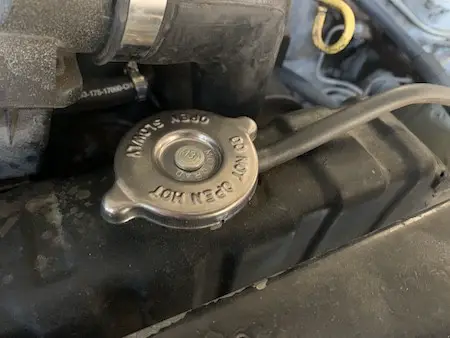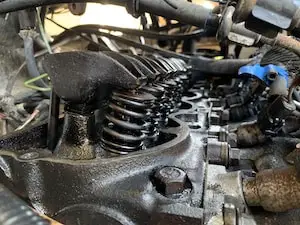A radiator can develop corrosion from sitting for long periods of time without use, and mineral deposits when regular un-distilled water is used. My newly purchased vehicle unfortunately had a partially plugged radiator and after personally diagnosing and repairing the radiator I would like to share what I learned.
My Radiator is not cooling well – Is it blocked?
A radiator’s cooling issues are more often caused by a faulty thermostat preventing the circulation of coolant through the engine block, but a radiator may also become blocked. Determine if your radiator is plugged by testing the thermostat, pouring fluid through the radiator, inspecting the fins, and the temperature on the radiator.

Old coolant is a common cause of a blocked radiator. If your car has been driven frequently and the coolant changed regularly then most likely the radiator is not plugged but rather the thermostat needs to be replaced.
how to check if radiator is blocked
how to test radiator for blockage at home
If your vehicle has sat for a long time, or a long time went between adding fresh coolant to the car, or if regular water was used rather than distilled, it is possible that the radiator has developed a blockage.
1. Pour Fluid Through the Radiator to Determine if the Flow is Restricted
To determine if the flow of fluid is restricted in the radiator, the best test is to open the drain plug, or better yet, disconnect the lower radiator hose, and pour water in the top of the radiator.
Don’t forget to catch the coolant with a bucket!
If the fluid does not flow freely out the drain plug, or at the same speed out the lower radiator hose as you pour it in, then there is a partial blockage.
The best thing to do with a partial blockage is to use a radiator flush liquid. The link is to Amazon to buy some for about 10 bucks. There are many many types but I have tried this one and had success with it. Buy a few bottles, and clean out the radiator yourself!
If the radiator flow does not seem to be restricted, again it is the thermostat. Or…
The fins or another component of the radiator may be damaged.
2. Test the Thermostat
A faulty thermostat is the most likely reason that your car is having cooling issues. If you suspect that your radiator is plugged, then the first step is to inspect the thermostat. A corroded or broken thermostat should be replaced.
Put the thermostat in a pot of water and heat to a boil. You should be able to watch the thermostat open as the water approaches boiling. The thermostat temperature is generally 180°F or 190°F and the boiling point of water is 212°F.
A thermostat is a very cheap part and generally I recommend that you replace it. Thermostats go bad every couple of years simply because they are constantly exposed to very hot water and eventually degrade and stop working properly.
I have even heard stories of people accidentally putting the thermostat in upside down which causes problems so make sure it is facing the right direction!
Don’t forget to order a new gasket while you are getting a new thermostat.
How the cooling system works
To understand why I recommend checking/replacing the thermostat when you have a hunch that the radiator is blocked, is the thermostat acts as a gate for the flow of coolant to the engine.
Coolant flows through the engine and is circulated by the water pump.
Coolant flows past the thermostat once the coolant has reached the proper temperature to prevent coolant from circulating too soon. The thermostat allows the coolant to not circulate through the radiator until the engine has reached it’s optimal operating temperature.
Once the coolant is to the engine’s optimal operating temperature (generally between 180°F and 190°F) the thermostat opens allowing the fluid to pass from the engine block through the upper radiator hose and down the radiator.
The radiator passes the fluid through narrow tubes that are exposed to lots of air passing through the radiator fins as you cruise down the road.
The radiator would have to have a lot of gunk to have a blockage since there are many passage ways.
Often times if there is a restriction, it is only partial and can be repaired with a radiator flush.
3. Inspect the Fins on the Radiator
Closely inspect the fins on the front and back of the radiator.
Disconnect the battery if you get near the cooling fan since electric fans can turn on even when the car is off!
Look for any debris such as mud, leaves, trash, or anything else that can prevent air from flowing smoothly through the radiator.
Smashed and bent fins are a common issue with a radiator that isn’t cooling like it should, and if the fins are bent, simply but patiently bend them back as straight as you can with a flat head screwdriver.
You are also looking for damage that may be causing a blockage in the radiator
4. How the Pros test Radiator Blockages
The pro mechanics use a laser thermometer and check the temperature of the radiator at different points.
This is the most effective option but is difficult with limited tools.
I recommend investing a few bucks in a thermostat or take it to a shop where they can properly test the temperature of the radiator.
Fortunately there is a way for us DIYers if you would like to test it yourself.
How to test Radiator Temperature without Thermometer
Feel the temperature of the radiator in different areas by putting your hand close to it.
Be cautious not to burn yourself and don’t physically touch anything very hot, or get close to the cooling fans.
But this is the best way to test for internal damage to the radiator before taking it into the shop
Check Temperatures on the Radiator
Checking the temperature of the radiator is how you can determine if the radiator has an internal blockage or other internal damage. A radiator has a series of passageways and
It is possible for debris to get into a radiator, although unlikely. If there is debris it may block one of the passageways and when coolant is flowing through the rest of the radiator, the coolant will be hotter in the area that is stagnant.
Key Takeaways
- The most common cause for a radiator that is not cooling properly is a bad thermostat.
- Radiator flush works to break free corrosion and mineral deposits. A DIY flush is a unfortunately only a temporary fix if the cooling system is severely blocked.
- For a radiator that is partially blocked, using a radiator flush fluid is the best way to fix it yourself.
- If the radiator is very plugged you should take it to a radiator repair shop
Learn more about thermostats – How they work and how to replace them in my article all about thermostats


